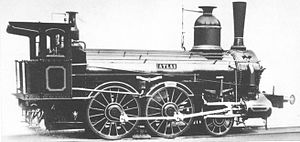Saxon II (State Railroad)
| II | |
|---|---|
| Number: | 90 |
| Manufacturer: | Saxon machine factory |
| Year of construction (s): | 1854-1868 |
| Retirement: | 1882-1914 |
| Axis formula : | 1 B |
| Service mass: | 28.9 Mp-33.9 Mp 283.5 kN-332.6 kN |
| Friction mass: | 21.5 Mp-25.5 Mp 210.9 kN-250.2 kN |
| Wheel set mass : | 10.6 Mp-12.8 Mp 104.0 kN-125.6 kN |
| Coupling wheel diameter: | 1,525 mm |
| Impeller diameter front: | 990 mm, also 916 mm or 1,016 mm |
| Cylinder diameter: | 406 mm, 407 mm |
| Piston stroke: | 610 mm |
| Boiler overpressure: | 7 kg / cm² 68.6 kN / cm² |
| Grate area: | 1.3 m², 1.25 m² |
| Evaporation heating surface: | 81.2 m² - 100.7 m² |
| Locomotive brake: | Steam sledge or steam block brake |
As Genus II designated Royal Saxon State Railways four-coupled Schlepptender locomotives for mixed services.
history
The first locomotives of this type were of H artmann for the Saxon-Bavarian and the Podkrušnohorský state railway in the years 1854 / 55 built. More locomotives received
- the Saxon-Bohemian State Railway
- the Saxon-Silesian State Railway
- the Zittau-Reichenberger Railway
- the Löbau-Zittau Railway
- the Western State Railway and
- the Eastern State Railway .
On January 1, 1859, the Saxon Eastern State Railroad from the Saxon-Bohemian and Saxon-Silesian State Railways and the Western State Railroad u. a. originated from the Saxon-Bavarian and the Niedererzgebirgische Staatsbahn. All of these railways either belonged to the state or had commissioned a state railroad to manage operations so that locomotives could be procured centrally. Up to 1868 a total of 90 locomotives had been procured, all of which were built by Hartmann in Chemnitz and which differed little technically.
All locomotives had a boiler with a smooth upper edge of upright and long boilers. The first delivery series was only equipped with a valve attachment on the boiler. All later had a steam dome, which sat either in the middle of the long boiler or on the first boiler section close behind the chimney. Until 1863, the front pipe wall was riveted in the middle of the first boiler section, later locomotives were again supplied with normal smoke chambers. If locomotives were to be fired primarily with Bohemian lignite , the normal chimney was replaced by one with a spark arrester attachment . The machines had an inner frame, which in the course of procurement developed from a fork frame to a sheet metal frame by reinforcing the lower chords. All axles were firmly mounted in the frame, the springs of the driving axles were connected by compensating levers. The vehicles had external cylinders and mostly an internal Stephenson control, some locomotives also had a Gonzenbach double slide control. The braking equipment was different. There were locomotives without their own brakes, with steam sled brakes and with steam block brakes. The locomotive 265 of the Eastern State Railways had a counter-vapor brake . When they were delivered, the locomotives did not have cabs until 1864; older machines were retrofitted with them in the mid-1860s. The sandpits that originally sat in front of the driving axis were later z. Partly replaced by a central sandpit on the top of the boiler.
All locomotives had names. From 1858 they also received company numbers. The locomotives in the western network had numbers below 200, those in the eastern network over 200. (The number could even be used to distinguish the Saxon-Bavarian machines from the Lower Ore Mountains.) The private locomotives were given separate company numbers. The merger to form the Royal Saxon State Railways in 1869 initially did not change the locomotive designation. In 1871 the locomotives of the Löbau-Zittau Railway also came to the State Railway. Since 1869, Franz Novotny also became a new director for mechanical engineering at K. Sächs. Sts. EB was responsible and the newly built 1B locomotives differed significantly from the older ones, from 1871 onwards the older state railway machines were given the class H III , for the new ones the class H IIIb was provided. From 1885 the generic symbol changed to H II . However, the first locomotives had already been taken out of service in 1884. In 1892, 75 of the former 85 state railway locomotives were given the consecutive road numbers 601 to 675 and lost their nameplates in the process. From 1896 the generic name was only II . From 1900 the company numbers were increased by 2000, but this only affected about half of the locomotives. The last ones were shut down until 1914.
The locomotives of the Zittau-Reichenberger Eisenbahn bore the operating numbers 8 to 12 and the generic designations valid for the state railroad. (It does not seem certain whether this information was also written on it, at least they wore their nameplates until the nationalization.) Since they were replaced by class IIIb locomotives between 1882 and 1900 , none of them made it to the State Railways in 1905.
literature
- Fritz Näbrich, Günter Meyer, Reiner Preuß : Lokomotivarchiv Sachsen 1 , transpress VEB Verlag for Transport, Berlin, 1983
- Erich Preuß , Reiner Preuß: Saxon State Railways , transpress Verlagsgesellschaft mbH, Berlin, 1991, ISBN 3-344-70700-0
